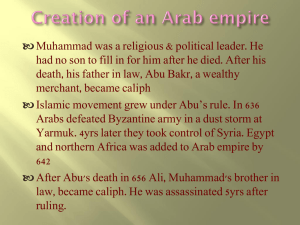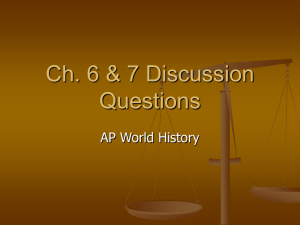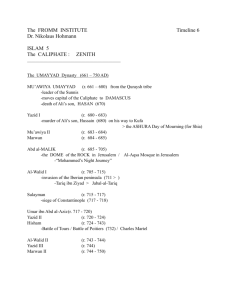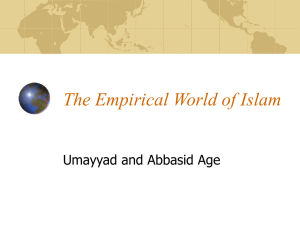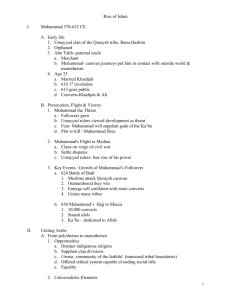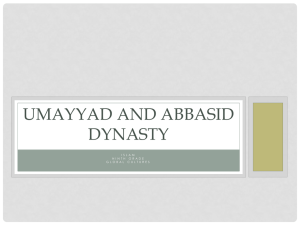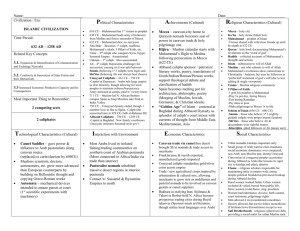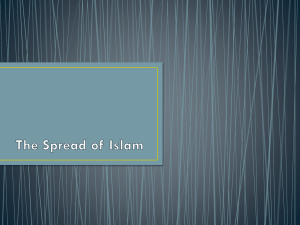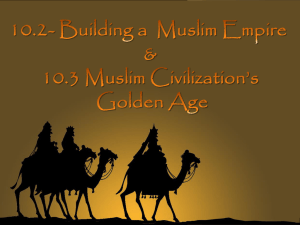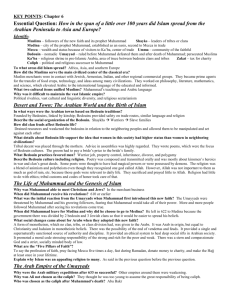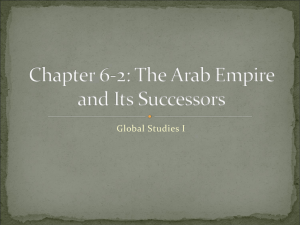The Arab Empire of the Umayyads - Mrs. Booth`s Social Studies
advertisement
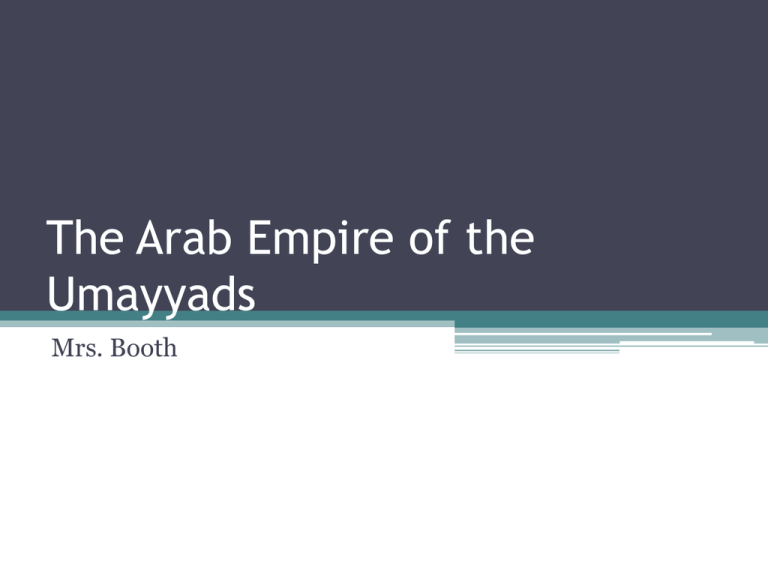
The Arab Empire of the Umayyads Mrs. Booth Bellringer • Unlike the Umayyad Empire, The Abbasid Empire • A) practiced absolutism • B) admitted Mawali as full members of the Islamic community • C) freed all slaves • D) persecuted the Shi’a • E) imposed austerity on the caliph Muhammad Dies • 632 CE- Muhammad dies • Muslim community still hold together • Old adversaries, Umayyad seize leadership of the Muslim faithful • Begin conquests throughout Middle East and North Africa Arab Conquest • Muslim military conquests mount beyond the peninsula • The courage, military prowess, and religious zeal of the warriors of Islam and the weaknesses of the empires that border Arabia, resulted in stunning conquests in Mesopotamia, north Africa, and Persia • Empire built from this conquest is Arab rather than Islamic because most was ruled by small Arab warrior elite controlled by the Umayyad Division in Islamic Community • Muhammad had not appointed a successor before his death in 632 • He had not even established a procedure by which to appoint/elect/pass leadership. • Opinion in Muslim community is deeply divided as to who shall lead next • The leader who would succeed him would be known as the caliph, OR, the political and religious successor to Muhammad. Candidates • Ali- son in law and cousin of Muhammad (yikes) – passed over because he is considered too young • Abu Bakr- one of Muhammad’s earliest followers and closest friends • Caliph from 632-634 Motives for Arab Conquest • Unity provided by Islamic faith gave new sense of common strength • Now they could stand up against non-Arab rulers who had previously played clans against one another • Above all, Bedouins are drawn to Arab expansion and conquest by the promise of a share of the rich conquered farmland. Problem of Succession and the SunniShi’a Split • Stunning success of Muslim armies and growing Arab empire temporarily diverted attention from the divisions and arguments going on within the Muslim community. • Began to boil over with the issue of how the booty should be divided up among the tribal groups that made up the Islamic community (conquered land) Growing Tensions lead to Violence • Spark of violence: Murder of the 3rd caliph, Uthman, by warriors returning from Egypt • His death was the signal for the supporters of Ali, to proclaim him as caliph • Uthman had not been popular among many tribes, especially the early followers, because he was the first caliph chosen from the Umayyad clan. • Umayyad reject Ali’s claims – warfare errupts between factions Ali • Famous warrior now • Gains upper hand after victory at Battle of Camel in 656 • Just as Ali is about to defeat Umayyad forces at Battle of Siffin in 657, he accepts a plea for mediation with Umayyad. • This is HEAVILY criticized, and many of his followers turn their back on Ali Mu’awiya • • • • 660- proclaimed leader (caliph) in Jerusalem Directly challenges Ali’s position 661- Ali assassinated From this point on Sunnis- back the Umayyad and Shi’a- supporters of Ali/anti-Umayyad • Mecca remains Holy City, but political center if of Umayyads is moved to Damascus in Syria Family and Gender Roles in the Umayyad Age • Islam greatly strengthened position of women • Seclusion and subordination of women common among other societies within the Middle East at this time • Qur’an forbides multiple marriages if the husband cannot take care of multiple wives or treat them all equally • Women could not have more than one husband Umayyad Decline and Fall • Ummayyad caliph’s growing addiction to luxury and wealth • Abandon simple life promoted by Muhammad and his earliest Caliphs, and now have pleasure gardens and marble palaces Rise of the Abbasid • 50,000 warrior settlers are angered by lack of booty from previous expansions and defense of frontiers (angry with Umayyad) • March under the banner of Abbasid party- trace their descent from Muhammad’s uncle al-Abbas • Abu-al-Abbas, great grandson of al Abbas leads forces Umayyad Fall • Abbasid forces gain strength due to the help of the Shi’a, mawali (non Arab converts to Islam) • Wanting to eliminate Umayyad family altogether, Abu al-Abbas invited many Umayyad leaders to a “reconciliation banquet” where he had them killed • Grandson of a former Caliph does flee to Spain and founds “caliphate of Cordoba” Abbasid Empire • Under Abbasids, Islam becomes a universal religion that spreads across much of North Africa and Euro-Asia. • Abbasid Capital was Baghdad • Great time of urban expansion that was linked to a revival of the Afro-Eurasian trade work that had declined with the fall of the Han dynasty and the slow collapse of the Roman Empire • Abbasid domain in West and Tang and Song in East revive commercial system Technology • Arab dhows, sailing vessels with lateen or triangular sails, carry goods and people (religious people) from place to place • These ultimately influence European ship design Social/Intellectual • Slaves were a major part of this society • They could work up enough money or power to buy back freedom or be released • Great mosques are built during this time • Focus on math and science • Never before had a civilization spanned so many different cultures and combined such a patchwork of linguistic groups, religions, and ethnic types Thesis Practice • Analyze the similarities and differences in the rise of the Umayyads and the Abbasids. SPRITE Chart Practice • Fill out a sprite chart on both empires with SPRITE facts that would contribute to your thesis and a powerful comparative essay.
